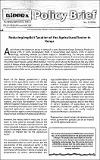| dc.contributor.advisor | Ochieng, James & Agwaya, Rodgers | |
| dc.date.accessioned | 2021-04-10T13:59:28Z | |
| dc.date.available | 2021-04-10T13:59:28Z | |
| dc.date.issued | 2020 | |
| dc.identifier.uri | http://repository.kippra.or.ke/handle/123456789/2792 | |
| dc.description.abstract | Excise taxes are an important source of revenue in most developing countries including Kenya. Excise taxes constitute a significant proportion of revenue in Kenya, between 1980 and 2018, excises in Kenya yielded an average of 3.1 per cent of GDP. This paper analyses the performance of excise taxes in Kenya over the last 3 decades. It also reviews the institutional and regulatory framework governing the excise tax system in Kenya. Further, using KIHBS data and employing Deaton’s AIDS model, elasticities of demand for tobacco, alcoholic products, financial services and petroleum products are measured by estimating the demand functions of the excisable products. The study finds negative price elasticities for all the excisable products. However, soft drinks and financial services have the least price elasticities of demand, ranging from -0.210 to -0.548 and -0.203 to -0.635 respectively. Depending on the policy objective, the levying of excise taxes should be treated with caution as any increases in excise tax rates may result in undesirable outcomes and therefore, should not be guided by the concept of elasticity alone. | en |
| dc.language.iso | en | en |
| dc.publisher | The Kenya Institute for Public Policy Research and Analysis (KIPPRA) | en |
| dc.relation.ispartofseries | DP/241/2020 | |
| dc.subject | Taxation | en |
| dc.subject | Excise Taxation | en |
| dc.subject | Revenue Generation | en |
| dc.subject | Tax Reforms | en |
| dc.subject | Tax Basket | en |
| dc.subject | Regional Economic Blocs | en |
| dc.title | Discussion Paper No. 241 of 2020 on Excise Taxation in Kenya: A Situation Analysis | en |
| dc.type | KIPPRA Publications | en |
| ppr.contributor.author | Ochieng, James & Agwaya Rodgers | |




